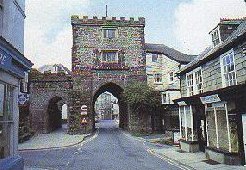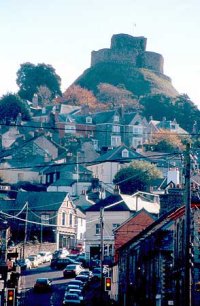


Ancient Capital and
Gateway to Cornwall
Web: www.visitlaunceston.co.uk
Web: www.visitcornwall.com/destinations/launceston
Launceston is the chief town of a wide area lying between Dartmoor and Bodmin Moor. In Saxon times it was the site of a Royal Mint. By the twelfth century the town itself had become walled (the only walled town in Cornwall) and for centuries the Assizes were housed here, in the castle itself and Guildhalls in the town. A Royal Charter was granted to the town in 1555. The population of the town was 8,952 at the 2011 census.
Launceston is situated just over one mile west of the River Tamar which marks the border between Cornwall and Devon and is often referred to as the "gateway to Cornwall". Dunheved was the Saxon name for the town. The A30 road used to pass through the town centre but a dual carriageway bypass now carries traffic south of the town. The bypass crosses the River Tamar on the Dunheved Bridge and was opened in 1976.
The town is built on the side of a large hill, which makes it almost immune to flooding, unlike the nearby suburb of Newport, situated at the bottom of the hill, which is susceptible to flooding by the River Kensey.

The hill top castle was strategically positioned to guard the main route into Cornwall. This subsequently became the seat of the Earls of Cornwall. The Southgate Arch is the only one to survive of the four original gates. A notable old sycamore once grew out of Southgate's walls and was much loved by the town's people, but this was cut down in 1953 as it was deemed to be causing damage to the building. Launceston became Cornwall's capital until the growth of Bodmin in the 19th century. Executions were carried out here until 1821; St. Cuthbert Mayne, a priest, was hung, drawn and quartered on the castle walls in 1577.
During the Civil War Launceston was known to be Royale et Loyale to King Charles I, hence its coat of arms. His son, the Prince of Wales, stayed in the town for a couple of days en route to the Royalist army based further down into Cornwall.
In 1643, however, the Parliamentarian forces under the command of Oliver Cromwell advanced in an attempt to capture Launceston from the Royalists. The Royalist army stationed their forces on the summit of Windmill Hill, the steep hill which overlooks the town. The Parliamentarians captured the town, but were unable to dislodge the Royalist forces from Windmill Hill. Sir Richard Grenville was committed by Prince Charles to Launceston Prison, for refusing to obey Sir Ralph Hopton, commander of the Royalist army, who organised a cavalry charge down the hill, and despite fierce fighting, managed to force Cromwell's divisions back across the Tamar. Launceston eventually fell to Cromwell in 1645.
Launceston was the capital of Cornwall from 1752 until this title passed to Bodmin in 1838), and the Prince of Wales comes to Launceston Castle once in his lifetime as Duke of Cornwall to receive the feudal dues which are his right from the Duchy of Cornwall. In 1201 Assizes were first held in the town, when the king sent judges on circuit to administer royal justice.
Launceston was always an important market centre; the rights to hold such markets were among the privileges granted by Royal Charter. Copies of these Charters together with other historical papers are housed in the Archives at Lawrence House Museum.
Other places of interest include the Northgate and Prison, where the Quaker George Fox was imprisoned in 1656, Southgate arch which now incorporates an Art Gallery, the Town Hall with its fine clock and the Town Square and surrounding narrow streets where Georgian houses stand in splendid array - of which the poet laureate Sir John Betjeman said: "the most perfect collection of 18th century town-houses in Cornwall".
On the first and third Saturdays of each month (from the beginning of March to the end of December) from 9am to 1pm there is a Butter Market in the town's square. The 16 or so stalls offer a wide range of first class West Country produce - some to try and some to buy - including home-made bread, cakes and pies, honey, eggs, fruit and vegetables, sausages, meat, cheese, plants etc. The original Butter-market building was demolished in 1921 and a new war memorial was built in its place.

Launceston Priory
Launceston Priory was founded in 1126 on the banks of the River Kensey close to where there is now an ancient clapper bridge and the parish church of St. Thomas. The priory had great influence and wealth up to the 16th century, but suffered the fate of many a fine religious building during the Dissolution of the Monasteries, it was raised to the ground by Henry VIII in 1539. In the late 19th century, the site was re-discovered during the building of the railway line to Launceston. The site has yielded enough to determine the exact layout and composition of the building and will be preserved as a site of historic interest to the area.
St. Mary Magdalene Church
This magnificent church, completed in 1524 by Sir Henry Trecarrell in the very centre of Launceston, is highly regarded for the ornamental and intricate carvings on the exterior stonework. Granite is not the easiest of stone to work and one must presume that highly skilled and experienced local stone masons carried out the work. The church tower is said to hold the first public clock in Cornwall, which was installed in 1431, the original clock has undoubtedly been replaced and various parts renewed on many occasions. Records show that the clock face was renovated by a Birmingham clockmaker for the princely sum of £58 17s 6d in 1888. The church was restored at a cost of £3,000 in 1894 under the plans of John Dando Sedding, but he died before the work could be carried out, and it was managed by Edmund Harold Sedding and Henry Wilson. A side chapel was added to the south aisle of the church. New seating was provided in the north and south aisles, and oak benches provided for the centre aisles. High up on the gable end of the church is a carved coat of arms of Henry VIII, the only one in Cornwall.
The Royal Mint at Launceston
There is historical evidence to support the location of a mint in Launceston as early as the Saxon and Norman periods, with coinage being issued for Cornwall and many other parts of the country. Early coins bore the inscription 'LANSTF', later 'STEFANT' and 'LANST' all being derivations of St. Stephens and/or Launceston. The mint seems to have ceased production in the early 13th century, the closure is not documented and therefore it remains a mystery as to why such an important and already old establishment should have been closed.
Launceston Technology College first established in 1409, became a boys grammar school with boarding house. Famous former students include Roger Moore of James Bond fame. In 1962, Horwell Grammar School for Girls, located in Newport Launceston, merged and in 1965 the former Pennygillam School was added to form the present day comprehensive school which is still known as Launceston College.
The elevated levels of Launceston Golf Club and its well-established course offer spectacular countryside views over both Dartmoor and Bodmin Moor, with majestic views over the historic town.
The town's Tourist Information Centre is at White Hart Arcade, Broad Street, PL15 8AA.
The local leisure centre is in Coronation Park, PL15 9DQ.
Well worth a visit is Launceston's Steam Railway, Cornwall's famous narrow gauge line, for a five mile round trip along the old North Cornwall railway, which originally was the main railway line down through Cornwall to Padstow.
Launceston was once served by two different railway lines. The Great Western Railway (GWR) branch from Plymouth terminated in the town and the London and South Western Railway (LSWR) Exeter to Padstow North Cornwall line which opened in 1892, passed through. Launceston's two stations were adjacent to each other. The GWR station closed to passengers in 1952 after which all trains used the LSWR station until the North Cornwall line also closed to passengers in 1966.
Also nearby is The Tamar Otter Sanctuary, only five miles to the north, and Lakeside Gallery four miles to the south of the town.
The Town Trail which is approx 1.5 miles takes in many old streets and buildings including the castle. More information and a leaflet can be obtained from the Tourist Information Centre.
Mary Ann Davenport (1759-1843), Notable actress born in Launceston.
Francis Vyvyan Jago Arundell (1780-1846), born in Launceston and being the only son of Thomas Jago, a solicitor in that town, who had married Catherine, a daughter of Mr Bolt, a surgeon at Launceston. He was in later life the Rector of Landulph, an antiquary and an oriental traveller.
Charles Causley (1917-2003), was born and brought up in Launceston and lived here for most of his life. When he was only seven his father died from wounds sustained during the First World War. His poetry was recognised by the Queen's Gold Medal for Poetry in 1967 and a Cholmondeley Award in 1971. He became one of the "best loved and most needed" poets of the last fifty years. A festival is held in his name during the first week in June every year.
James Ruse (1760-1837), from Launceston, arrived in New South Wales aboard the transport ship 'Scarborough', part of the First Fleet of Australian convict ships, in 1788.
Captain Philip Gidley King (1758-1808), from Launceston joined the Royal Navy at the age of twelve as captain's servant, and later became Governor of New South Wales, Australia.
John Couch Adams (1819-1892), from nearby Laneast discovered the planet Neptune in 1846.
William Mitchinson Hicks, FRS (1850-1934), from Launceston was a British mathematician and physicist. Hicks equation is named after him.
John Alexander McGeoch (1955–2004), was a Scottish musician and songwriter who died at his home in Launceston.
Sir Alfred Farthing Robbins (1856-1931), journalist, political biographer and freemason, author of Launceston, Past and Present (1888)
Joan Rendell MBE (1921-2010.) Author who lived most of her life at Werrington, near Launceston
The Launceston Steam Rally - end of May.
The Charles Causley Festival - June.
The Launceston Agricultural Show - July. The show was first held in 1887.
Altarnun Bodmin Moor Bude Callington Gunnislake Antique Chairs Museum
Cullacott Lawrence House Museum Launceston's Steam Railway Launceston Castle
Ellis Nurseries & Gardens Hidden Valley Discovery Park New Mills Farm Park
Charles Causley The Tamar Otter Sanctuary Trethorne Leisure Park The Trafalgar Way Tamara Way